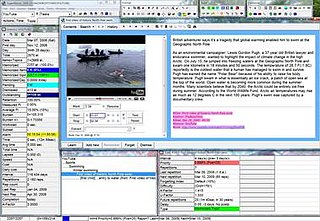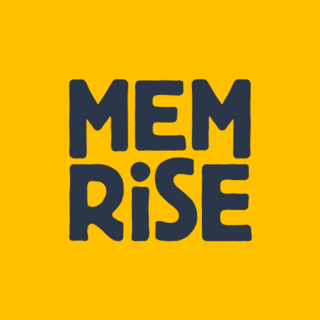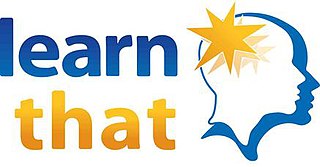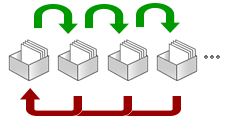
Incremental reading is a software-assisted method for learning and retaining information from reading, which involves the creation of flashcards out of electronic articles. "Incremental reading" means "reading in portions". Instead of a linear reading of articles one at a time, the method works by keeping a large list of electronic articles or books and reading parts of several articles in each session. The user prioritizes articles in the reading list. During reading, key points of articles are broken up into flashcards, which are then learned and reviewed over an extended period with the help of a spaced repetition algorithm.

Spaced repetition is an evidence-based learning technique that is usually performed with flashcards. Newly introduced and more difficult flashcards are shown more frequently, while older and less difficult flashcards are shown less frequently in order to exploit the psychological spacing effect. The use of spaced repetition has been proven to increase the rate of learning.

SuperMemo is a learning method and software package developed by SuperMemo World and SuperMemo R&D with Piotr Woźniak in Poland from 1985 to the present. It is based on research into long-term memory, and is a practical application of the spaced repetition learning method that has been proposed for efficient instruction by a number of psychologists as early as in the 1930s.
A vocabulary is a set of words, typically the set in a language or the set known to an individual. The word vocabulary originated from the Latin vocabulum, meaning "a word, name". It forms an essential component of language and communication, helping convey thoughts, ideas, emotions, and information. Vocabulary can be oral, written, or signed and can be categorized into two main types: active vocabulary and passive vocabulary. An individual's vocabulary continually evolves through various methods, including direct instruction, independent reading, and natural language exposure, but it can also shrink due to forgetting, trauma, or disease. Furthermore, vocabulary is a significant focus of study across various disciplines, like linguistics, education, psychology, and artificial intelligence. Vocabulary is not limited to single words; it also encompasses multi-word units known as collocations, idioms, and other types of phraseology. Acquiring an adequate vocabulary is one of the largest challenges in learning a second language.

Rote learning is a memorization technique based on repetition. The method rests on the premise that the recall of repeated material becomes faster the more one repeats it. Some of the alternatives to rote learning include meaningful learning, associative learning, spaced repetition and active learning.
Linkword is a mnemonic system promoted by Michael Gruneberg since at least the early 1980s for learning languages based on the similarity of the sounds of words. The process involves creating an easily visualized scene that will link the words together. One example is the Russian word for cow : think and visualize "I ran my car over a cow."
Pythagorean Method of Memorization (PYMOM), also known as Triangular Movement Cycle (TMC), is a game-based, educational methodology or associative-learning technique that primarily uses corresponding information, such as terms and definitions on opposing sides, displayed on cue cards, to exploit psychological retention of information for academic study and language acquisition. PYMOM is named such because of the shape the cue-cards form during the progression of the game, a right-angled or Pythagorean triangle.

Study skills or study strategies are approaches applied to learning. Study skills are an array of skills which tackle the process of organizing and taking in new information, retaining information, or dealing with assessments. They are discrete techniques that can be learned, usually in a short time, and applied to all or most fields of study. More broadly, any skill which boosts a person's ability to study, retain and recall information which assists in and passing exams can be termed a study skill, and this could include time management and motivational techniques.
Sebastian Leitner was a German commentator and science popularizer.

The Leitner system is a widely used method of efficiently using flashcards that was proposed by the German science journalist Sebastian Leitner in 1972. It is a simple implementation of the principle of spaced repetition, where cards are reviewed at increasing intervals.
Studying in an educational context refers to the process of gaining mastery of a certain area of information. Study software then is any program which allows students to improve the time they spend thinking about, learning and studying that information.

Mnemosyne is a line of spaced repetition software developed since 2003. Spaced repetition is an evidence-based learning technique that has been shown to increase the rate of memorization.

Anki is a free and open-source flashcard program. It uses techniques from cognitive science such as active recall testing and spaced repetition to aid the user in memorization. The name comes from the Japanese word for "memorization".

Memrise is a British language platform that uses spaced repetition of flashcards to increase the rate of learning. It is based in London, UK.

OpenCards is a free spaced repetition flashcard program. The software is similar to SuperMemo, Anki or Mnemosyne.
Distributed practice is a learning strategy, where practice is broken up into a number of short sessions over a longer period of time. Humans and other animals learn items in a list more effectively when they are studied in several sessions spread out over a long period of time, rather than studied repeatedly in a short period of time, a phenomenon called the spacing effect. The opposite, massed practice, consists of fewer, longer training sessions and is generally a less effective method of learning. For example, when studying for an exam, dispersing your studying more frequently over a larger period of time will result in more effective learning than intense study the night before.

LearnThat Foundation is an American 501(c)3 nonprofit organization that develops and manages an online vocabulary and spelling program along with a free multimedia learners' dictionary, Open Dictionary of English (ODE). The foundation was founded in February 2004 under the name eSpindle Learning. In August 2010, the name was changed to LearnThat Foundation, and its domain was moved to www.LearnThat.org. The program is branded as LearnThatWord.
Fresh Memory is a spaced repetition flashcard application, similar to SuperMemo.
A desirable difficulty is a learning task that requires a considerable but desirable amount of effort, thereby improving long-term performance. It is also described as a learning level achieved through a sequence of learning tasks and feedback that lead to enhanced learning and transfer.
Brainscape is a web and mobile education platform that allows students to study adaptive flashcards. The website and mobile application allow students, teachers, and corporate trainers to create electronic flashcards, and to find flashcards created by other users and publishers around the world. Brainscape flashcards and marketing content are also created by expert educators and publishers with whom Brainscape closely partners to create flashcards aligned to strict instructional guidelines. Flashcards are all stored in the cloud and can be shared with groups of other learners.











